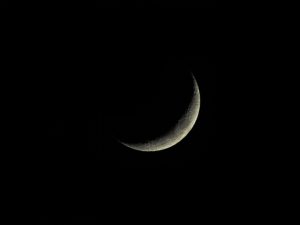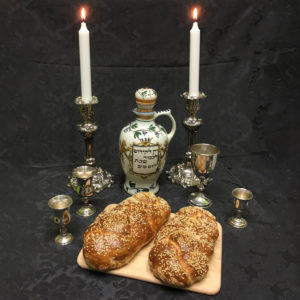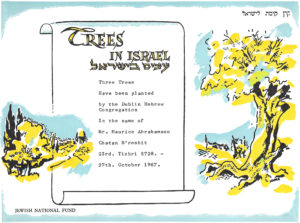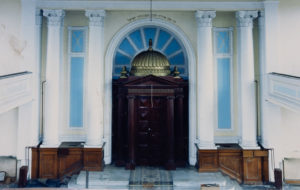Exploring Judaism
Here is some basic information about topics in Judaism to help students understand key aspects of the Jewish religion that we get asked about frequently.
Jump to section
Jewish Calendar
Yearly Cycle
The Hebrew calendar is lunisolar, based on both the lunar and solar cycles. It is important that these cycles coincide.
The Torah teaches us that Pesach (Passover) is a Spring festival and as such must always occur in the Spring.
The solar calendar is 365 ¼ days, whereas a 12 month lunar calendar is 354 days leaving a shortage of 11 days.
Every 4 years the solar calendar has a leap year of one extra day on 29 February.
In order to keep Jewish festivals in their seasons a lunar leap month of 30 days is added to Adar. This occurs 7 times in 19 years.
Hebrew Months
| Month | Transliteration | Month falls between |
|---|---|---|
| ניסן | Nissan | March - April |
| אייר | Iyar | April - May |
| סיון | Sivan | May - June |
| תמוז | Tammuz | June - July |
| אב | Av | July - August |
| אלול | Elul | August - September |
| תשׁרי | Tishrei | September - October |
| חשׁון | Chesvan | October - November |
| ּכסלו | Kislev | November - December |
| טבת | Tevet | Third December - January |
| שׁבט | Shevat | January - February |
| אדר א | Adar | February - March |
| אדר ב | Adar Sheni | Lunar Leap Month |
Shabbat and the Festivals
A day in Jewish Life begins in the evening, it says In the Torah, “and there was evening, and there was morning, a first day….” Genesis chapter 1 verse 5 and so Shabbat and Festivals start the evening beforehand.
Rosh Chodesh

The first day of each Hebrew month – when the new moon appears.
Yom Kippur – 10 Tishrei

Day of Atonement – 25 hour fast when neither food nor drink is taken. The focus of the service which continues throughout the period is on repentance, prayer and atonement.
Three Pilgrim Festivals
Traditionally Jewish people gathered at the Temple in Jerusalem on Pesach, Shavuot and Sukkot, bringing harvest offerings. Although there is no Temple today, each Jewish community celebrates these festivals in their own homes and synagogues.
Sukkot – 15 Tishrei
Feast of Tabernacles, 8 day festival, reminding us of the journey from Egypt, living in temporary shelters during the 40 years of wandering in the wilderness, these dwellings were called Sukkot. Also when the Children of Israel were finally living in the Promised Land they celebrated the Autumn harvest festival of the year.
Synagogue
The Aron Kodesh
The Holy Ark is where the Torah Scrolls of The Law are kept. A depiction of the ten commandments is over the Ark A parochet (curtain) hangs in front of the doors, to remind us of the curtain that covered the Ark of the Covenant, as we read in Exodus chapter 40 verse 21.
The Home
Pesach
An eight day festival celebrating the redemption from slavery in Egypt. Our houses must be cleaned from cellar to attic – no chametz (anything with leaven) may be eaten for a week.
On the first and second night a Seder – special meal is held, the Haggadah is read recounting the story of the Exodus – special symbolic food is eaten and children are encouraged to ask questions.
Seder Dish
The seder plate holds at least six of the ritual items that are talked about during the seder: the shankbone, karpas, chazeret, charoset, maror, and egg.
- Zeroah – roasted lamb shankbone: commemorates the paschal (lamb) sacrifice made the night the ancient Hebrews left Egypt. The blood of the lamb was painted on the door posts of the houses of the Hebrews so that the angel of death would “passover” their houses.
- Baytzah – the roasted egg: symbolises springtime and renewal and reminds us of one of the sacrificial offerings which was performed in the days of the Second Temple.
- Maror – bitter herb: horseradish is the most common. Bitter herbs bring tears to the eyes and recall the bitterness of slavery.
- Charoset – mixture of grated apples, nuts, wine, and cinnamon that represents the mortar used by the Hebrew slaves to make bricks.
- Karpas – parsley reminds us of spring, dip a sprig into salt water – then eat.
- Chazeret – a second bitter herb, most often romaine lettuce or onion.
- Salt water – Salt water symbolizes the tears and sweat of enslavement.
Four Cups of Wine (or grape juice)
Each person at the seder has a small cup or glass from which they drink four cups of wine. Traditionally, the four cups represent the four biblical promises of redemption:
“I will bring you out from under the burdens of the Egyptians,
I will rid you from their slavery,
I will redeem you with an outstretched arm, and with great judgments.
I will take you to me for a people.”
Matzah
Unleavened bread – the most important symbol of Pesach is a plate with three pieces of matzah, covered with a Matzah dekel – a cloth.
Thought to represent:
- Cohenim – the high priests – descended from Aharon
- Levites – who assisted the priests – descended from tribe of Levi.
- Israelites – descended from Jacob – whose name was changed to Israel.
Keeping Kosher
Meat
Only those animals that have both cloven hooves and chew the cud, such as cows, sheep, goats and some wild animals such as deer. Pigs are not permitted because they do not chew the cud.
Birds or Fowl
Domestic birds such as chickens, turkeys, ducks and geese may be eaten, however birds of prey are not permitted.
Animals and birds must be ritually killed by a “Shochet” a person trained in the laws of “Shechita” – a quick and painless method of slaughter. The process drains all blood, certain fats and the sciatic nerve, only then can it be pronounced as Kosher – fit to eat.
Fish
Must have both fins and scales and must not be scavengers. Shell fish is not permitted.
Milk and Eggs
Must only come from Kosher Animals or birds.
The Torah forbids the cooking and eating of meat and milk products together. Therefore it is necessary to have at least two sets of cooking and eating utensils – even the washing up is done separately. There also needs to be an interval between eating meat and dairy products and also between eating dairy and meat products.
Fruit and Vegetables
Must be carefully inspected to make sure that they are insect, bug and mould free.
Ritual Objects
Torah
Torah is the name given to the first Five Books of the Bible.
- Bereishit (Genesis )
- Shemot. (Exodus)
- Vakira. (Leviticus)
- Bamidbar. (Numbers)
- Devarim. (Deuteronomy)
Mezuzah
Tefillin
2 small leather boxes, square and painted black containing 4 carefully written paragraphs from the Torah –
- Exodus chapter 13 verses 1–10
- Exodus chapter 13 verses 11–16
- Deuteronomy chapter 6 verses 4–9
- Deuteronomy chapter 11 verses 13–21
They are worn, attached by leather straps, on the upper left arm and on the head. Males over the age of 13 (Bar Mitzvah) wear these at the weakly morning service.
Both the Mezuzah and the Tefillin serve to remind us to keep and to do G-d’s commandments as we leave and enter the house and as we stand and pray in the morning.
Chanukiah
During Chanukah (also known as the Festival of Lights) a nine branched candelabra with eight candles in a row and a separate light known as the shamash (servant) is lit. The shamash and one candle on the first night, the shamash and two on the second and so on until all eight candles are lit on the final night.
This commemorates the number of days it took for the Maccabees to bring fresh oil to rededicate the Temple — during this time an oil lamp with a single cruse of oil which would normally give light for one day, burnt for the whole eight
Rites of Passage
Birth

Marriage
A traditional Jewish wedding takes place under a Chuppah (Marriage Canopy). The bride and groom stand together with the rabbi and the ceremony begins with the rabbi reciting the betrothal blessing over a cup of wine, he gives a sip of wine to the groom and then to the bride.
The groom places a ring on the bride’s finger and recites the betrothal pledge. The Ketubah (marriage contract) is read out and the Sheva B’rachot (seven blessings) are recited. Finally a glass is put on the floor and the groom smashes it with his foot, the wedding is over and people shout out Mazel Tov! Good luck!
Death
When a death occurs the person is prepared by washing carefully, dressed in a simple white shroud and then placed in a plain wooden coffin. This work is carried out by a group called the Chevra Kadisha: men prepare males and women prepare females.
Funerals take place very soon after death, after the interment. Shiva, a period of seven days of mourning, is observed by the immediate family. Family and friends come to comfort the mourners in their home and prayers are recited.






























